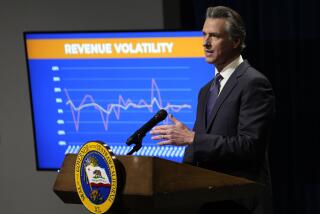Editorial: California’s budget surplus? Look again
- Share via
Actuaries hired by outgoing state Controller John Chiang have found that paying for all the health benefits promised to current state employees when they retire will cost almost $72 billion, taking a much larger slice from the state budget than is now spent on retirees’ coverage. The revelation is just the latest sign that the state’s budget surplus isn’t a real windfall, given the long-term fiscal problems festering in Sacramento. Gov. Jerry Brown is expected to unveil a plan next month to start paying down the retiree health program’s unfunded liabilities, which have grown by a third in the last eight years. It’s commendable that the state at last is owning up to this issue, but its dithering has raised the price tag considerably.
California offers its retired employees subsidized health coverage that continues until they reach age 65, at which point the state aid supplements the Medicare benefits provided by the federal government. Retirees who worked for the state for at least 10 years have 50% or more of their premiums covered. For retirees with 20 or more years of service, the state pays 100% of the average premium — more than it does for active workers. Unlike workers’ pensions, though, the state doesn’t set aside any money to pay for most of its future retirees’ healthcare costs, nor does it ask employees to contribute anything toward that cost. Instead, it dips into the general fund each year to pay for current retirees’ health coverage.
That pay-as-you-go strategy costs less in the short term but more in the long run, sacrificing whatever gains the state could be making by collecting money now for future retiree benefits and investing it. And because retirees are living longer and healthcare is getting more expensive, the future bill for those benefits is growing to gigantic proportions. The state’s annual costs have risen as well; it now spends almost $1.9 billion a year, according to the actuaries’ report. But lawmakers would have to spend almost twice as much to stop the state from sinking deeper into the hole on future retirees’ benefits.
The real problem with the pay-as-you-go approach is that it disguises the true cost of the benefits that the state negotiates with the unions representing the 261,000 active state workers and 168,000 retirees. Pre-funding the benefits would make the cost clear, but it’s expensive: an additional $1.8 billion a year, or enough to fund the entire University of California system for a quarter. Chiang has proposed to increase the state’s contribution by $1.7 billion over five years, which would reduce the unfunded liability by almost $20 billion. That would be a start, but the state shouldn’t expect taxpayers to cover the entire amount. It’s reasonable to ask state workers to pitch in too, as Highway Patrol officers and two other groups of state workers have done in recent years. Brown has also floated a plan in the past to require workers to put in more years before qualifying for retiree health benefits, which could help reduce the state’s liabilities but would probably have to be negotiated with the unions.
Whatever approach the state takes, it can’t keep ignoring what it costs to offer health benefits to future retirees. Rather than continuing to dig a deeper fiscal hole, lawmakers have to start filling it.
Follow the Opinion section on Twitter @latimesopinion
More to Read
A cure for the common opinion
Get thought-provoking perspectives with our weekly newsletter.
You may occasionally receive promotional content from the Los Angeles Times.










